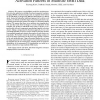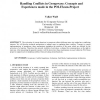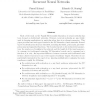COGSR
2010
13 years 10 months ago
2010
Ontologies, as knowledge engineering tools, allow information to be modelled in ways resembling to those used by the human brain, and may be very useful in the context of personal...
SODA
2010
ACM
14 years 28 days ago
2010
ACM
Motivated by issues of saving energy in data centers we define a collection of new problems referred to as "machine activation" problems. The central framework we introd...
ICDM
2010
IEEE
14 years 1 months ago
2010
IEEE
In this paper we propose two methods to derive two different kinds of node similarities in a network based on their neighborhood. The first similarity measure focuses on the overla...
TMI
2010
14 years 1 months ago
2010
Abstract—We propose a probabilistic model for analyzing spatial activation patterns in multiple functional magnetic resonance imaging (fMRI) activation images such as repeated ob...
NRHM
2000
14 years 2 months ago
2000
Activation and deactivation of media items plays a fundamental role in the playing of multimedia and time-based hypermedia presentations. Activation and deactivation information t...
INTERACT
1997
14 years 4 months ago
1997
The activation of certain functions in groupware affects different users who might have conflicting interests. We will develop technical mechanisms to support users in regulating t...
EUROCOLT
1997
Springer
14 years 7 months ago
1997
Springer
Most of the work on the Vapnik-Chervonenkis dimension of neural networks has been focused on feedforward networks. However, recurrent networks are also widely used in learning app...
INFOCOM
2005
IEEE
14 years 8 months ago
2005
IEEE
— We consider a network of rechargeable sensors, deployed redundantly in a random sensing environment, and address the problem of how sensor nodes should be activated dynamically...
MIR
2006
ACM
14 years 9 months ago
2006
ACM
This paper introduces a content-based information retrieval method inspired by the ideas of spreading activation models. In response to a given query, the proposed approach comput...
IJCNN
2007
IEEE
14 years 9 months ago
2007
IEEE
—Default ARTMAP combines winner-take-all category node activation during training, distributed activation during testing, and a set of default parameter values that define a read...



